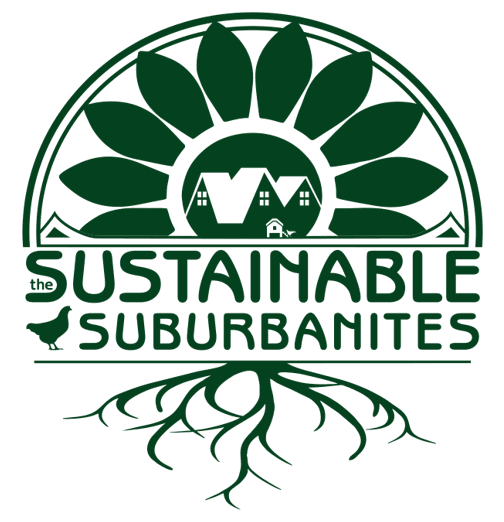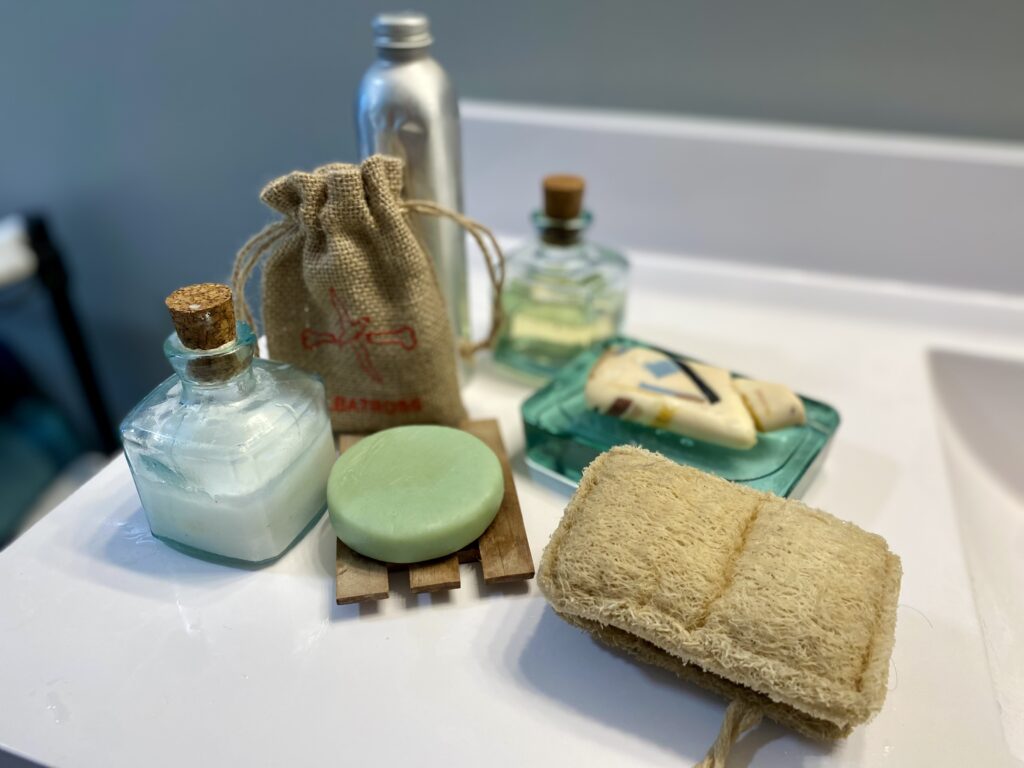Are you feeling a bit stuck in your sustainability game? Or maybe you’re just starting out and are looking for a place to start.
No matter where you are in your zero waste journey, this list has action items
Please note: This list is not exhaustive, nor is it perfectly suited for everyone. We sat down and cranked out a randomly ordered list of things we have done, or would like to do, and this is what we came up with.
My suggestion is to focus on what you can or will do, and ignore the rest. There will always be ways to live more sustainably that are unsuitable for your lifestyle or budget and that’s okay. Focus on what you can change. The list will always be endless.
This post may contain affiliate links, meaning we may earn a commission on purchases you make at no cost to you.
1. Wash your laundry in cold and Line-dry if possible.
2. Use bamboo toothbrushes and hairbrushes.
3. Use bar soap instead of liquids.
4. Carpool to work, if possible.
5. Walk or ride a bike to as many places as possible.
6. Buy local produce at Farmer’s Markets
7. Shop local and avoid large retailers whenever possible.
8. Use shampoo and conditioner bars instead of liquid.
9. Recycle as much as you can.
10. Brush up on curbside recycling rules in your area to avoid contamination.
11. Join or start a local Zero Waste group online to share resources.
12. Find out if there are drop sites for items that don’t go in curbside recycling in your area (ie: electronics, textiles)
13. Use the dishwasher whenever possible, and only run it when it is full.
14. Switch to plastic-free toothpaste tablets like Bite
15. Join or start a Buy Nothing group for your neighborhood. Be very active in it!
16. Continue to read and educate yourself on a variety of related disciplines. Check out our reading list!
17. Talk to your neighbors as frequently as possible about sustainability.
18. Create or expand your food garden or countertop growing spaces.
19. Keep chickens or other poultry for eggs and/or meat.
20. Use bar soap for hand washing instead of liquid.
21. Educate the children in your life via age-appropriate books about climate change and environmentalism.
22. Stack your trips in the car to complete as many as possible per outing to avoid driving.
23. Shop backward to avoid food waste. Start with what you already have, not what you want to make.
24. Find the closest zero waste shop to you. Consider if it is close enough to shop there regularly.
25. Find a law waste online shop, like EarthHero, that ships to your area for items you can’t find locally.
26. Practice asking yourself “What can I use this for?” before landfilling any item.
27. Replace “Throw Away” with “Landfill” in your daily vocabulary. There is no such thing as “away.”
28. Register to vote and vote in every election, local and national.
29. Plant as many native plants as possible instead of maintaining traditional lawn space.
30. Share sustainability resources on social media – pages, influencers, non-profits, local organizationss, etc.
31. Write to your local government about their climate change action plans. Write them again.
32. Be hopeful. Nihilism is tempting, but hope is found in action. Hope is contagious.
33. Become a Little Free Library Steward. Stock it with secondhand books from diverse authors.
34. Throw every penny you possibly can toward the sustainability resources most useful to you. (Shameless plug for us!)
35. Shop secondhand for clothes and miscellaneous housewares. Thrift shops are FULL of stuff.
36. Practice “making do” without as many items as possible. Get creative with substitutions.
37. Replace traditional dental floss with compostable dental floss.
38. Start composting – either with a DIY setup, or an industrial compost service
39. Always remember that there is enough in this world for us all. Remind everyone you know.
40. Stay current on medical care like vaccines, annual screenings, and wellness visits.
41. Volunteer with local groups or political candidates who have strong environmental plans.
42. Reduce your meat and dairy consumption.
43. Switch to compostable kitty litter and compost dog waste from the yard instead of landfill.
44. Use reusable liners or compostable materials in small pet cages.
45. Reuse fish tank or cooking water to water houseplants.
46. Start a culture of borrowing in your neighborhood.
47. Join your neighborhood association or HOA to start a discussion about removing strict regulations.
48. Unplug anything not actively being used – chargers, appliances, etc.
49. Collect rainwater in rain barrels to water outdoor gardens.
50. Spread out your lawn mowing schedule as far as possible.
51. Switch to a manual or electric lawnmower instead of gas-powered.
52. Encourage your children to use household objects as play items as opposed to purchasing many toys.
53. Provide only secondhand toys instead of buying new – explain why to your children.
54. Save small scraps from projects to use for future projects – fabric, wood etc.
55. Be organized! Knowing what you have and where it’s at is key to avoiding new purchases.
56. Emphasize quality over quantity in your beauty and personal care items.
57. Purchase as many things in bulk as possible. (Bonus points for refilling your own containers when possible!)
58. Invest in reusable containers for refill shopping, or clean out some nice glass jars from other foodstuffs.
59. Eliminate paper towels and napkins by investing in durable unpaper towels.
60. Switch to recycled paper toilet paper or un-toilet paper.
61. Purchase a bidet.
62. Start a conversation about recycling and compositing options in your workplace.
63. Pack home any waste that cannot be properly disposed of at work or while you’re out and about.
64. Use body products that come in compostable or recyclable packaging – deodorant in cardboard, lotion bars in tins, etc.
65. Use vinegar and water as a daily cleaning solution.
66. Mend your clothes, and refuse to give into fast fashion pressures.
67. Make things fun! You’re more likely to stick with changes if you find ways to make them enjoyable and affordable.
68. Invest in energy-efficient heating and cooling appliances if affordable.
69. Adjust your thermostat a few degrees higher or lower – your body will adjust to the seasons.
70. Pracrtice spotting greenwashing.
71. Accept that many solutions are imperfect but are still better than making no change.
72. Practice a “repair not replace” mindset. Support your local repair shops.
73. Save packaging items like twist ties and small screws to reuse.
74. Work to unlearn behaviors that drive us to consume unnecessary items as status symbols.
75. Check labels for ethics information. Consider where and how your purchases were manufactured.
76. Gift experiences like memberships to local attractions instead of physical gifts.
77. Try to normalize secondhand gifting in your family and circle of friends.
78. Get comfortable putting your foot down about your lifestyle changes being respected.
79. Be a resource for others, but don’t expect everyone to make exactly the same changes as you.
80. Seek out and elevate indigenous environmental leaders.
81. Switch to a more sustainable laundry detergent. We use TruEarth Laundry Strips. There are also sustainable pod options like Dropps.
90. Use dryer balls instead of dryer sheets when using a clothes dryer.
91. Dry like fabrics together to reduce dry time when using a clothes dryer.
92. Wear clothes more than once if they’re not dirty, particularly outerwear.
93. If you don’t use it, gift it. Keeping items in storage keeps them out of the hands of folks who need them.
94. Cut up worn-out clothes to use as cleaning rags.
95. Make a conscious effort to think about plastic when making purchases – both the item itself and the packaging it comes in.
96. Contact your favorite stores and brands to pressure them about sustainable practices.
97. Spend as much time as possible outdoors, and encourage your children to do the same.
98. Leave the leaves that fall from your trees on your lawn or use them in your garden.
99. Contact your municipality about pocket prairie or tree planting programs.
100. Stop using pest control sprays, and encourage your neighbors to do the same.
Bonus Sustainable Action Item!
For our 101st action, please always remember:
You can create change from within your own space. You don’t need to go elsewhere to become an activist. Using the skills you have in whatever place you exist to create sustainable change is something that each and every person can do.
Happy change making!

